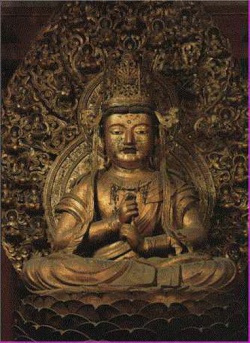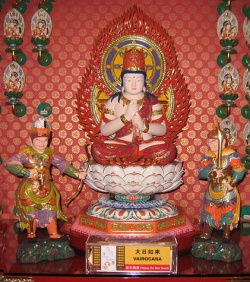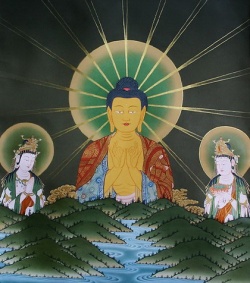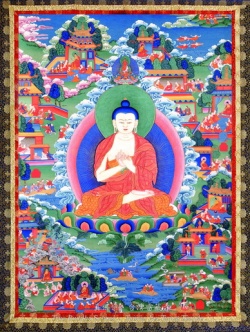Difference between revisions of "Mahavairocana Tantra"
(Created page with "thumb|250px| <poem> The Mahāvairocana Tantra (Chinese title: 大毘盧遮那成佛神變加持經) is an important Vajrayana Buddhist text. It ...") |
|||
| (19 intermediate revisions by 5 users not shown) | |||
| Line 1: | Line 1: | ||
[[File:Mahavairocanas01.jpg|thumb|250px|]] | [[File:Mahavairocanas01.jpg|thumb|250px|]] | ||
| + | |||
| + | |||
| + | |||
<poem> | <poem> | ||
| − | The | + | |
| + | The [[MahāVairocana Tantra]] ({{Wiki|Chinese}} title: [[大毘盧遮那成佛神變加持經]]) is an important [[Vajrayana]] [[Buddhist text]]. | ||
| + | |||
| + | It is also known as the [[MahāVairocana Abhisaṃ Bodhi Tantra]], or more fully as the [[Mahā Vairocana Abhisaṃ Bodhi Vikurvita Adhiṣṭhāna Tantra]]. | ||
| + | |||
| + | In [[Tibet]] it is considered to be a member of the [[Carya class of Tantras]]. | ||
| + | |||
| + | In [[Japan]] where it is known as the [[MahāVairocana Sūtra]], it is one of two central texts in the [[Shingon]] school, along with the [[Vajrasekhara Sutra]]. | ||
| + | |||
| + | Both are also part of the [[Tendai]] school. | ||
| + | |||
| + | |||
| + | |||
| + | Composition & {{Wiki|history}} | ||
| + | |||
| + | |||
| + | |||
| + | The [[MahāVairocana Tantra]] is the first true [[Buddhist Tantra]], the earliest comprehensive manual of [[Tantric Buddhism]]. | ||
| + | |||
| + | It was probably composed in the middle of the 7th century, in all {{Wiki|probability}} in north-eastern [[India]] at [[Nālandā]]. | ||
| + | |||
| + | The [[Sanskrit]] text of the [[MahāVairocana Tantra]] is lost, but it survives in {{Wiki|Chinese}} and [[Tibetan]] translations. | ||
| + | |||
| + | The {{Wiki|Chinese}} translation has preserved the original [[Sanskrit]] [[mantras]] in the [[Siddhaṃ script]]. | ||
| + | |||
| + | |||
| + | There are translations from both into English. | ||
| + | |||
| + | |||
| + | The text was translated into {{Wiki|Chinese}} in 724 by [[Śubhakarasiṃha]] who had travelled to [[China]] from [[Nālandā]]. | ||
| + | |||
| + | It is possible that the [[Sanskrit]] text was taken to [[China]] circa 674 by the {{Wiki|Chinese}} [[pilgrim]] [[Wu-xing]]. | ||
| + | |||
| + | It was translated into [[Tibetan]] sometime before 812 by [[Śīlendrabodhi]] and [[dPal brTsegs]]. | ||
| + | |||
| + | |||
| − | + | A major commentary by [[Buddhaguhya]] was written in about 760 and is preserved in [[Tibetan]]. | |
| − | + | Hodge translates it into English alongside the text itself. | |
| − | + | [[Kūkai]] discovered the [[MahāVairocana Tantra]] in 796, and travelled to [[China]] in 804 to receive instruction in it. | |
| − | |||
| − | |||
Contents | Contents | ||
| − | The | + | |
| + | The [[Mahā Vairocana Tantra]] consists of three [[primary]] [[mandalas]] [[corresponding]] to the [[Body]], [[speech]] and [[Mind]] of [[MahāVairocana]], as well as [[preliminary practices]] and [[initiation]] [[Rituals]]. | ||
| + | |||
| + | According to [[Buddhaguhya’s]] [[Piṇḍārtha]] (a summary of the main points of the [[Tantra]]) the [[Mahā Vairocana Tantra]] system of practice is in three stages: | ||
| + | |||
| + | preliminary, application, and [[accomplishment]]. | ||
| + | |||
| + | |||
| + | [[Attached]] here and there are [[doctrinal]] passages, and [[sadhana]] practices which relate back to the main [[mandalas]]. | ||
[[File:Mahavairocana595.jpg|thumb|250px|]] | [[File:Mahavairocana595.jpg|thumb|250px|]] | ||
| − | The following outline is based on Hodges translation of the Tibetan version of the Sutra. The Chinese version has differences in the order of the chapters. | + | |
| + | The following outline is based on Hodges translation of the [[Tibetan]] version of the [[Sutra]]. | ||
| + | |||
| + | The {{Wiki|Chinese}} version has differences in the [[order]] of the chapters. | ||
| + | |||
| + | |||
Chapters | Chapters | ||
| − | |||
| − | II-VI Three chapter on the | + | I - The [[Sutra]] begins in a timeless setting of [[Mahavairocana]] [[Buddha]]'s palace ([[symbolizing]] all of [[existence]]), with a {{Wiki|dialogue}} between [[Mahavairocana]] [[Buddha]] and his [[Disciple]] [[Vajrasattva]]. |
| − | VII-IX Three miscellaneous chapters originally at the end of the text. They are at the end in the Chinese version. | + | |
| − | X-XII Three chapters on the | + | In [[chapter]] one, [[Mahavairocana]] [[Buddha]] expounds the [[Dharma]] to a great host of [[bodhisattvas]], with {{Wiki|emphasis}} on the relationship between [[Form]] and [[Emptiness]]. |
| − | XII-XVI Five chapters on the | + | |
| − | XVII A stand alone chapter that may once have circulated separately. | + | |
| − | XVIII-XIX A further chapter regarding meditating on the letters of the alphabet which involves placing them around the | + | II-VI Three [[chapter]] on the [[Mandala of the Body Mystery]] with detailed instruction on the laying out of the [[Mandala]] and the [[abhiṣekha]] [[Ritual]]. |
| − | XX A standalone chapter address to bodhisattvas | + | |
| − | XXI-XXV Four chapters on the 100 syllable | + | This [[Mandala]] is also known as the [[Mandala of the Womb Realm]] ([[Sanskrit]] : [[Garbhakosha]]). |
| − | XXVI-XXX Five miscellaneous chapters including the six homa rites. | + | |
| + | |||
| + | |||
| + | VII-IX Three miscellaneous chapters originally at the end of the text. They are at the end in the {{Wiki|Chinese}} version. | ||
| + | |||
| + | X-XII Three chapters on the [[Mandala of the Speech Mystery]]. | ||
| + | |||
| + | Includes a series of glosses on [[meditating]] using the [[letter]] of the [[alphabet]] in various combinations. | ||
| + | |||
| + | |||
| + | XII-XVI Five chapters on the [[Mandala of the Mind Mystery]] | ||
| + | |||
| + | XVII A stand alone [[chapter]] that may once have circulated separately. | ||
| + | |||
| + | XVIII-XIX A further [[chapter]] regarding [[meditating]] on the letters of the [[alphabet]] which involves placing them around the [[Body]] while [[visualising]] oneself as The [[Buddha]]. | ||
| + | |||
| + | |||
| + | XX A standalone [[chapter]] address to [[bodhisattvas]] | ||
| + | |||
| + | XXI-XXV Four chapters on the 100 {{Wiki|syllable}} [[Meditation]]. | ||
| + | |||
| + | XXVI-XXX Five miscellaneous chapters [[including]] the [[six homa rites]]. | ||
| + | |||
| + | |||
| − | Esoteric Precepts | + | ===[[Esoteric Precepts]]=== |
| − | |||
| − | Not to abandon the true Dharma | + | [[Chapter]] 2 of the [[Sutra]] also contains four [[precepts]], called the [[Samaya]], that [[Form]] the basic [[precepts]] [[esoteric]] [[Buddhist]] practitioners must follow: |
| − | Not to deviate from one's own | + | |
| − | Not to be reserved in sharing with others the Buddhist teachings | + | |
| − | Not to bring harm to any | + | Not to abandon the true [[Dharma]] |
| + | |||
| + | Not to deviate from one's [[own]] [[Enlightened Mind]] | ||
| + | |||
| + | Not to be reserved in sharing with others the [[Buddhist teachings]] | ||
| + | |||
| + | Not to bring harm to any [[Sentient beings]] | ||
| + | |||
[[File:Mahavairocana101lg.jpg|thumb|250px|]] | [[File:Mahavairocana101lg.jpg|thumb|250px|]] | ||
| − | |||
| − | |||
| − | |||
| − | |||
| − | |||
| − | |||
| − | |||
| − | |||
| − | |||
| − | Understanding of Enlightenment | + | ===[[Shingon Lineage]]=== |
| + | |||
| + | |||
| + | The [[Mahavairocana Tantra]] does not trace its [[lineage]] to [[Shakyamuni Buddha]], the founder of [[Buddhism]]. | ||
| + | |||
| + | Instead it comes directly from [[Mahavairocana]]. | ||
| + | |||
| + | The [[lineage]] then [[being]], according to the [[Shingon]] [[tradition]]: | ||
| + | |||
| + | |||
| + | |||
| + | [[Vajrasattva]], the [[Disciple]] of [[Mahavairocana]] [[Buddha]] in this [[Sutra]]. | ||
| + | |||
| + | [[Nagarjuna]] received the text of the [[Mahā Vairocana Tantra]] directly from [[Vajrasattva]] inside an {{Wiki|iron}} [[Stupa]] in {{Wiki|South India}}. | ||
| + | |||
| + | [[Nagabodhi]], [[Nagarjuna]]'s [[Disciple]] | ||
| + | |||
| + | [[Vajrabodhi]], an [[Indian]] [[Monk]] famous for translating [[esoteric]] [[Rituals]] into {{Wiki|Chinese}} [[Language]] | ||
| + | |||
| + | [[Amoghavajra]], [[Vajrabodhi's]] famous [[Disciple]], and expert in [[esoteric]] practices | ||
| + | |||
| + | [[Hui-kuo]], a {{Wiki|Chinese}} [[esoteric]] [[master]] | ||
| + | |||
| + | [[Kukai]], founder of [[Shingon Buddhism]] in [[Japan]]. | ||
| + | |||
| + | |||
| + | |||
| + | ===[[Understanding of Enlightenment]]=== | ||
| + | |||
| + | |||
| + | |||
| + | Within the [[vision]] of the [[Mahavairocana Sutra]], the [[state]] of [[Bodhi]] ([[Awakening]] / | ||
| + | |||
| + | [[Enlightenment]]) is seen as naturally [[inherent]] to the [[Mind]] - the [[Mind]]'s natural and [[pure]] [[state]] (as in [[Dzogchen]] and [[Tathagatagarbha]]) | ||
| + | |||
| + | - and is viewed as the {{Wiki|perceptual}} [[sphere]] of [[Non-duality]], | ||
| + | |||
| + | where all false {{Wiki|distinctions}} between a perceiving [[subject]] and [[perceived]] [[objects]] are lifted and the true [[state]] of things ([[Non-duality]]) is revealed. | ||
| − | |||
| − | ... when the MVT [i.e. Mahavairocana Tantra] speaks of knowing your | + | This is also the [[understanding]] of [[Enlightenment]] found in [[Yogacara]] [[Buddhism]]. To achieve this [[vision]] of [[Non-duality]], it is necessary to recognise one's [[own]] [[Mind]]. |
| + | |||
| + | |||
| + | [[Writing]] on the [[Mahavairocana Sutra]], [[Buddhist scholar]] and [[translator]] of that [[scripture]], [[Stephen Hodge]], comments: | ||
| + | |||
| + | |||
| + | |||
| + | ... when the MVT [i.e. [[Mahavairocana Tantra]]) speaks of [[knowing]] your [[Mind]] as it truly is, it means that you are to know the [[inherent]] natural [[state]] of the [[Mind]] by eliminating the split into a perceiving [[subject]] and [[perceived]] [[objects]] which normally occurs in the [[World]] and is wrongly [[Thought]] to be real. | ||
| + | |||
| + | |||
| + | This also corresponds to the [[Yogacara]] [[definition]] ... that [[Emptiness]] ([[Sunyata]]) is the absence of this [[imaginary]] split. ... | ||
| + | |||
| + | We may further elucidate the meaning of [[Perfect Enlightenment]] and hence of the [[intrinsic nature]] of the [[Mind]])] by corrrelating terms [which [[Buddhist]] commentator on the [[Mahavairocana Sutra]], [[Buddhaguhya]], treats as synonyms. | ||
| + | |||
| + | For example, he defines [[Emptiness]] ([[Sunyata]]) as [[suchness]] ([[Tathata]]) and says that [[suchness]] is the [[intrinsic nature of the Mind]] ([[Svabhava]]), which is [[Enlightenment]] ([[Bodhi-Citta]]). | ||
| + | |||
| + | |||
| + | |||
| + | Moreover, he frequently uses the terms [[suchness]] ([[Tathata]]) and [[Suchness-Awareness]] ([[Tathata-jnana]]) interchangeably. | ||
| + | |||
| + | But since [[Awareness]] ([[jnana]]) is [[non-dual]], [[Suchness-Awareness]] is not so much the [[Awareness of Suchness]], but the [[Awareness which is Suchness]]. | ||
| + | |||
| + | In other words, the term [[Suchness-Awareness]] is functionally {{Wiki|equivalent}} to [[Enlightenment]]. | ||
| + | |||
| + | |||
| + | Finally, it must not be forgotten that this [[Suchness-Awareness]] or [[Perfect Enlightenment]] is [[Mahavairocana]] the [[Primal Buddha]], uncreated and forever [[existent]]. | ||
| + | |||
| + | In other words, the [[Mind]] in its intrinsic [[nature]] is [[Mahavairocana]], whom one "becomes" (or vice-versa) when one is perfectly [[Enlightened]]. | ||
[[File:Mahavairocana-101.jpg|thumb|250px|]] | [[File:Mahavairocana-101.jpg|thumb|250px|]] | ||
| − | |||
| − | Yet ultimately even | + | The text also speaks of how all things can be accomplished once '[[non-dual]] union with [[Emptiness]]' is [[attained]]. |
| + | |||
| + | Yet ultimately even [[Emptiness]] needs to be transcended, to the extent that it is not a [[vacuous]] [[Emptiness]], but the expanse of the [[Mind]] of [[Buddha]], [[Buddhic]] [[Awareness]] and [[Buddha-realms]], all of which [[know]] of no beginning and no [[arising]] - as [[Stephen Hodge]] points out: | ||
| + | |||
| + | |||
| + | |||
| + | Finally, though one has [[realized]] the true [[Emptiness]] of the {{Wiki|individual}} and [[Phenomena]], one does not yet realize that the natural [[state]] of [[Mind]] is the [[Tathagata's]] [[inherent]] [[Awareness]] and that it is the all-pervasive [[Body]] of [[Vairocana]] with all the [[manifested]] [[Buddha realms]]. | ||
| + | |||
| + | Therefore one must transcend even [[Emptiness]] with the [[Emptiness]] of [[Emptiness]], when it is seen that the [[Mind]] is [[primordially]] {{Wiki|unborn}} and unarisen. | ||
| + | |||
| + | |||
| + | The [[Sutra]] later reinforces the notion that [[Emptiness]] is not mere inert [[nothingness]] but is precisely the unlocalised locus where [[Vairocana]] resides. [[Vajrapani]] salutes The [[Buddha]] [[Vairocana]] with the following words: | ||
| + | |||
| + | |||
| + | |||
| + | I salute you who are [[Bodhicitta]] [[Awakened Mind]]! | ||
| + | |||
| + | I salute you who are the source of [[Enlightenment]]! [...] | ||
| + | |||
| + | I [[bow]] to you who reside in [[Emptiness]]!' | ||
| + | |||
| + | |||
| + | [[Emptiness]] in [[Buddhist]] {{Wiki|discourse}} usually means the flow of [[causation]] and result - the [[arising]] of [[causes]] and [[conditions]] - but in this [[scripture]], [[Mahavairocana]] [[Buddha]] declares himself to be separate from all [[causes]] and [[conditions]] and without defect - truly mighty: | ||
| − | |||
| − | + | I who am mighty have been renowned as the Great [[Hero]]. | |
| − | + | I directly [[realized]] that there is no [[arising]], and abandoned the {{Wiki|perceptual}} range of words; | |
| − | + | I became free from all faults, and separated from [[causes]] and [[conditions]]. | |
| − | |||
| − | |||
| − | |||
</poem> | </poem> | ||
{{W}} | {{W}} | ||
[[Category:Buddhist Terms]] | [[Category:Buddhist Terms]] | ||
| − | [[Category: | + | [[Category:Mahavairocana Tantra]] |
[[Category:Vairocana]] | [[Category:Vairocana]] | ||
Latest revision as of 14:07, 21 November 2020
The MahāVairocana Tantra (Chinese title: 大毘盧遮那成佛神變加持經) is an important Vajrayana Buddhist text.
It is also known as the MahāVairocana Abhisaṃ Bodhi Tantra, or more fully as the Mahā Vairocana Abhisaṃ Bodhi Vikurvita Adhiṣṭhāna Tantra.
In Tibet it is considered to be a member of the Carya class of Tantras.
In Japan where it is known as the MahāVairocana Sūtra, it is one of two central texts in the Shingon school, along with the Vajrasekhara Sutra.
Both are also part of the Tendai school.
Composition & history
The MahāVairocana Tantra is the first true Buddhist Tantra, the earliest comprehensive manual of Tantric Buddhism.
It was probably composed in the middle of the 7th century, in all probability in north-eastern India at Nālandā.
The Sanskrit text of the MahāVairocana Tantra is lost, but it survives in Chinese and Tibetan translations.
The Chinese translation has preserved the original Sanskrit mantras in the Siddhaṃ script.
There are translations from both into English.
The text was translated into Chinese in 724 by Śubhakarasiṃha who had travelled to China from Nālandā.
It is possible that the Sanskrit text was taken to China circa 674 by the Chinese pilgrim Wu-xing.
It was translated into Tibetan sometime before 812 by Śīlendrabodhi and dPal brTsegs.
A major commentary by Buddhaguhya was written in about 760 and is preserved in Tibetan.
Hodge translates it into English alongside the text itself.
Kūkai discovered the MahāVairocana Tantra in 796, and travelled to China in 804 to receive instruction in it.
Contents
The Mahā Vairocana Tantra consists of three primary mandalas corresponding to the Body, speech and Mind of MahāVairocana, as well as preliminary practices and initiation Rituals.
According to Buddhaguhya’s Piṇḍārtha (a summary of the main points of the Tantra) the Mahā Vairocana Tantra system of practice is in three stages:
preliminary, application, and accomplishment.
Attached here and there are doctrinal passages, and sadhana practices which relate back to the main mandalas.
The following outline is based on Hodges translation of the Tibetan version of the Sutra.
The Chinese version has differences in the order of the chapters.
Chapters
I - The Sutra begins in a timeless setting of Mahavairocana Buddha's palace (symbolizing all of existence), with a dialogue between Mahavairocana Buddha and his Disciple Vajrasattva.
In chapter one, Mahavairocana Buddha expounds the Dharma to a great host of bodhisattvas, with emphasis on the relationship between Form and Emptiness.
II-VI Three chapter on the Mandala of the Body Mystery with detailed instruction on the laying out of the Mandala and the abhiṣekha Ritual.
This Mandala is also known as the Mandala of the Womb Realm (Sanskrit : Garbhakosha).
VII-IX Three miscellaneous chapters originally at the end of the text. They are at the end in the Chinese version.
X-XII Three chapters on the Mandala of the Speech Mystery.
Includes a series of glosses on meditating using the letter of the alphabet in various combinations.
XII-XVI Five chapters on the Mandala of the Mind Mystery
XVII A stand alone chapter that may once have circulated separately.
XVIII-XIX A further chapter regarding meditating on the letters of the alphabet which involves placing them around the Body while visualising oneself as The Buddha.
XX A standalone chapter address to bodhisattvas
XXI-XXV Four chapters on the 100 syllable Meditation.
XXVI-XXX Five miscellaneous chapters including the six homa rites.
===Esoteric Precepts===
Chapter 2 of the Sutra also contains four precepts, called the Samaya, that Form the basic precepts esoteric Buddhist practitioners must follow:
Not to abandon the true Dharma
Not to deviate from one's own Enlightened Mind
Not to be reserved in sharing with others the Buddhist teachings
Not to bring harm to any Sentient beings
===Shingon Lineage===
The Mahavairocana Tantra does not trace its lineage to Shakyamuni Buddha, the founder of Buddhism.
Instead it comes directly from Mahavairocana.
The lineage then being, according to the Shingon tradition:
Vajrasattva, the Disciple of Mahavairocana Buddha in this Sutra.
Nagarjuna received the text of the Mahā Vairocana Tantra directly from Vajrasattva inside an iron Stupa in South India.
Nagabodhi, Nagarjuna's Disciple
Vajrabodhi, an Indian Monk famous for translating esoteric Rituals into Chinese Language
Amoghavajra, Vajrabodhi's famous Disciple, and expert in esoteric practices
Hui-kuo, a Chinese esoteric master
Kukai, founder of Shingon Buddhism in Japan.
===Understanding of Enlightenment===
Within the vision of the Mahavairocana Sutra, the state of Bodhi (Awakening /
Enlightenment) is seen as naturally inherent to the Mind - the Mind's natural and pure state (as in Dzogchen and Tathagatagarbha)
- and is viewed as the perceptual sphere of Non-duality,
where all false distinctions between a perceiving subject and perceived objects are lifted and the true state of things (Non-duality) is revealed.
This is also the understanding of Enlightenment found in Yogacara Buddhism. To achieve this vision of Non-duality, it is necessary to recognise one's own Mind.
Writing on the Mahavairocana Sutra, Buddhist scholar and translator of that scripture, Stephen Hodge, comments:
... when the MVT [i.e. Mahavairocana Tantra) speaks of knowing your Mind as it truly is, it means that you are to know the inherent natural state of the Mind by eliminating the split into a perceiving subject and perceived objects which normally occurs in the World and is wrongly Thought to be real.
This also corresponds to the Yogacara definition ... that Emptiness (Sunyata) is the absence of this imaginary split. ...
We may further elucidate the meaning of Perfect Enlightenment and hence of the intrinsic nature of the Mind)] by corrrelating terms [which Buddhist commentator on the Mahavairocana Sutra, Buddhaguhya, treats as synonyms.
For example, he defines Emptiness (Sunyata) as suchness (Tathata) and says that suchness is the intrinsic nature of the Mind (Svabhava), which is Enlightenment (Bodhi-Citta).
Moreover, he frequently uses the terms suchness (Tathata) and Suchness-Awareness (Tathata-jnana) interchangeably.
But since Awareness (jnana) is non-dual, Suchness-Awareness is not so much the Awareness of Suchness, but the Awareness which is Suchness.
In other words, the term Suchness-Awareness is functionally equivalent to Enlightenment.
Finally, it must not be forgotten that this Suchness-Awareness or Perfect Enlightenment is Mahavairocana the Primal Buddha, uncreated and forever existent.
In other words, the Mind in its intrinsic nature is Mahavairocana, whom one "becomes" (or vice-versa) when one is perfectly Enlightened.
The text also speaks of how all things can be accomplished once 'non-dual union with Emptiness' is attained.
Yet ultimately even Emptiness needs to be transcended, to the extent that it is not a vacuous Emptiness, but the expanse of the Mind of Buddha, Buddhic Awareness and Buddha-realms, all of which know of no beginning and no arising - as Stephen Hodge points out:
Finally, though one has realized the true Emptiness of the individual and Phenomena, one does not yet realize that the natural state of Mind is the Tathagata's inherent Awareness and that it is the all-pervasive Body of Vairocana with all the manifested Buddha realms.
Therefore one must transcend even Emptiness with the Emptiness of Emptiness, when it is seen that the Mind is primordially unborn and unarisen.
The Sutra later reinforces the notion that Emptiness is not mere inert nothingness but is precisely the unlocalised locus where Vairocana resides. Vajrapani salutes The Buddha Vairocana with the following words:
I salute you who are Bodhicitta Awakened Mind!
I salute you who are the source of Enlightenment! [...]
I bow to you who reside in Emptiness!'
Emptiness in Buddhist discourse usually means the flow of causation and result - the arising of causes and conditions - but in this scripture, Mahavairocana Buddha declares himself to be separate from all causes and conditions and without defect - truly mighty:
I who am mighty have been renowned as the Great Hero.
I directly realized that there is no arising, and abandoned the perceptual range of words;
I became free from all faults, and separated from causes and conditions.



